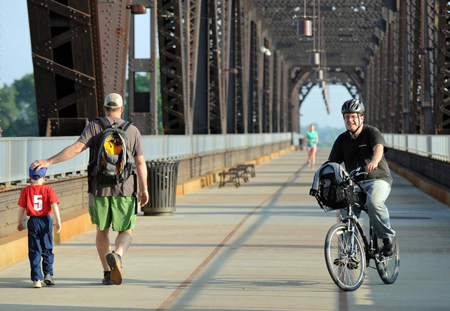DISCOVER YOUR LOCAL BICYCLING COMMUNITY
Find local advocacy groups, bike shops, instructors, clubs, classes and more!
BFC Spotlight: Louisville
This week, we announced the latest round of Bicycle Friendly Communities. Louisville, KY, is one of the 42 new and renewing communities this round, and the new Silver-level community is aiming to be the best in the region. We caught up with John “Rolf” Eisinger, the city’s bicycle and pedestrian coordinator, and with Chris Glasser, President of Bicycling for Louisville, to talk more about what this award means to the city and where they will go from here to reach Gold!
1. What does this award mean to you and to Louisville?
RE: This is a very big deal since we have been trying to reach silver for several years, but we were lacking the funds to build bike quality bike infrastructure. Then last year Mayor Greg Fischer’s administration invested $300,000 to build Louisville’s first urban bike network. This award will help validate that investment while providing support for an increase in funding in order to continue to expand the urban bike network.
CG: It means we’re improving, we’re getting better. But it also means we’re not there yet. There’s a lot of room for growth. If you look at cities like Portland or Madison, you realize how much more can be done to make a city bike-friendly.
2. What was the city’s biggest accomplishment in the past year?
RE: Hands down the Big Four Bridge opening has been the biggest accomplishment. This bike and pedestrian only bridge crosses the Ohio River linking Louisville, KY to Jeffersonville, IN. Our Eco counter is counting over 500,000 pedestrians and bikes crossing annually.
CG: The opening of the Big Four Bridge (a bike-ped bridge across the Ohio River) has been great for Louisville, and a total game-changer for Jeffersonville in southern Indiana. Their downtown is suddenly thriving — very walkabale, very bikeable. People are moving there, businesses are opening up there. It’s become this fantastic urban neighborhood with parks and restaurants, and just tons of people biking around everywhere. Jeffersonville has really embraced the bridge, and its impact is already huge.

Big Four Bridge. Photo courtesy of Indiana Economic Digest.
3. What’s on the to-do list for the next year?
RE: We are working hard to build out our urban bike network in preparation for a 2016 Bikeshare launch. We have a few projects we have been working on which would provide separated bike lanes through the heart of downtown in both west and south directions.
CG: A two-way protected bike lane on Jefferson Street in downtown Louisville. That would be the first of its kind in the city, and it would go through the middle of the Central Business District of the city. We also have a plan for a two-way protected bike lane on Lexington Road, which would connect into the Jefferson Street project to create a single four-mile cycletrack through city center.
4. Your regional neighbors in Memphis and Nashville also received awards this year — how does competition factor into your efforts? How do you view Louisville in comparison to its regional neighbors in terms of bike-friendliness?
RE: Friendly competition is always fun, and now we will all be going for gold and beyond so we can look to each other for continued lessons learned.
CG: I’m definitely aware of what’s happening in other Midwestern cities. Indianapolis has a great Cultural Trail. Cincinnati has built some protected bike lanes and invested in road diets on some of its major arterials. Those are great projects, and I’d love to see something comparable in Louisville. Right now, I think we’re a step or two behind in terms of building strong bike-friendly infrastructure, but I do think we have a Mayor for whom bike-friendliness is a big priority and a local culture that’s supportive. I’m optimistic we can catch up.
5. Anything else you’d like to add?
RE: Becoming a member of NACTO and the new FHWA Separated Bike Lane Guide have both been invaluable resources as we continue to build safe and highly utilized bike infrastructure. With an increase in bike infrastructure we have also seen a greater demand for bicycle education and the Louisville Bicycle Club has done an amazing job teaching adults League’s, Traffic Skills 101 course. Also, Bicycle for Louisville and our public schools have helped teach thousands of youth our Bike Sense curriculum.
CG: Worth noting: Unfortunately, most of the major roads Louisville are state roads, and our state-level transportation cabinet (KYTC) is somewhere between disinterested and antagonistic towards multi-modal design. Getting them to buy into creating bike-friendly designs is a big hurdle we’ve yet to clear.